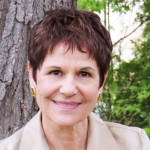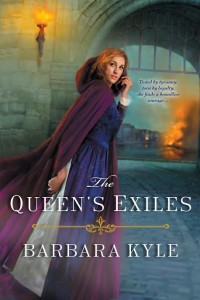I had the pleasure of meeting Barbara Kyle in person at the Historical Novel Society Conference in London, 2012. And what a lovely person she is!
Barbara writes both historical and contemporary fiction, leads workshops and speaks about writing. She studied theater and acted professionally for twenty years, mostly in television. No wonder she’s able to create such vibrant characters and deliver such action on the page! Barbara’s contemporary thrillers include Entrapped and The Experiement. In 2008 Kensington Books published Kyle’s first historical novel; set in King Henry VIII’s court, The Queen’s Lady became the first in a series of six novels – and counting! Barbara and her husband also enjoy sailing; she and I are connected through writing and water.
Here is Barbara Kyle sharing her experience and advice on writing a series…
How Fenella Became a Star: Thoughts on Writing a Series
by Barbara Kyle
 Publishers love series. No wonder. The Harry Potter empire has sold more than 400 million
Publishers love series. No wonder. The Harry Potter empire has sold more than 400 million
books. Nancy Drew? The 175 installments of the beloved mystery series have had sales of over
200 million. Of Twilight’s four books more than 100 million copies have been sold.
Publishers love series because readers love series. Just like TV, where viewers eagerly welcome
the same characters into their living rooms week after week—be it Downton Abbey, Breaking
Bad, Game of Thrones, or The Good Wife—readers of series by master storytellers like George
R. R. Martin, Diana Gabaldon, and Bernard Cornwell have the same addiction. They get to know
the continuing characters so well they can’t wait to find out what happens in the next book.
What happens in the next book can sometimes surprise the author. The surprise for me was
Fenella Doorn.
 Fenella is the heroine of my new historical thriller, The Queen’s Exiles. She’s a savvy Scottish-
Fenella is the heroine of my new historical thriller, The Queen’s Exiles. She’s a savvy Scottish-
born entrepreneur who salvages ships. This is the sixth book in my Thornleigh Saga which
follows a middle-class English family’s rise through three tumultuous Tudor reigns. In Book
4 Fenella played a small but crucial role in the plot, and then I forgot about her. She didn’t
appear in Book 5. But when I was planning Book 6, and focusing it on one of the series’ major
continuing characters, Fenella sneaked up me. A warm-hearted, determined, courageous woman,
she’s also rather cheeky and she insisted that I include her in the new story. She reminded me
that she’d had past connections with two exciting men in the series, Adam Thornleigh and Carlos
Valverde, which promised some dramatic sparks.
So, I did more than include her in the new book. I made her its star.
That can happen when you write a series —a secondary character can take over. I was glad
Fenella did. She offered me an opportunity to create a complex, admirable woman who doesn’t
fit the ingénue heroine so common in historical fiction. She’s not a young thing; she’s thirty.
She’s not a pampered lady; she rolls up her sleeves running her business of refitting ships.
She’s attractive but not a smooth-faced beauty; her cheek is scarred from a brute’s attack with a
bottle ten years ago. And she’s not a virgin; she was once the mistress of the commander of the
Edinburgh garrison (he of the bottle attack). In other words, Fenella is my kind of woman.
But making her the star of the new book in my series meant some serious recalibrating. How
could I fit her into the Thornleigh family? Writing a series opens up a vista of opportunities but
also a minefield of traps. I’ll share a few with you here.
1. Every Book is New
Don’t assume that readers have read the previous books in the series. My agent always reminds
me of this when I send him the outline for a new book in the Thornleigh Saga: “Many readers
won’t know what these characters have already been through.” So, each book has to give some
background about what’s happened to the main characters in the preceding books, enough to get
new readers up to speed. However, you can’t lay on so much backstory that you bore readers who
have followed all the books. Getting the balance right is tricky.
I like the way episodes in a TV series start with a helpful recap: “Previously on Downton
Abbey…” It’s perfect: it refreshes the memory of viewers who’ve seen the previous episodes, and
is just enough to tantalize those haven’t and bring them up to speed. I wish I could have a nice
announcer give a recap at the beginning of my Thornleigh books! The point is, each book in a
series must stand on its own. It has to be a complete and satisfying story for any reader.
2. Create a Series Bible
Before writing full time I enjoyed a twenty-year acting career, and one of the TV series I did was
a daytime drama (soap opera) called High Hopes. The writers on that series kept a story Bible: a
record of the myriad details that had to be consistent from show to show concerning the dozens
of characters. It’s a wise practice for the writer of a series of novels, too.
My Thornleigh Saga books follow a family for three generations (and counting), so it’s easy
to forget facts about a character that were covered three or four books ago. That’s why I keep
a Bible that keeps track of the characters’ ages, occupations, marriages, love affairs, children,
ages of their children, homes, character traits, and physical details like color of hair and eyes . . .
and missing body parts! Richard Thornleigh loses an eye in The Queen’s Lady, Book 1 of the
Thornleigh Saga, yet in later books I would often start to write things like, “His eyes were drawn
to …” So I keep that Bible near.
3. Consistency Can Yield Rewards
When I had a brute cut Fenella Doorn’s cheek in Book 4, The Queen’s Gamble, I never expected
Fenella to reappear in a future story. Two books later, when I brought her back to star in The
Queen’s Exiles, I could not ignore the fact that she would have a sizable scar on her cheek. So I
used that scar to enrich her character. She’d been a beauty at eighteen, relying on men to support
her, but when her cut face marred her beauty she realized that it was now up to her to put bread
on the table and clothes on her back. I made her ironically aware that the scar freed her from the
bonds of beauty; it made her independent. And she became a successful entrepreneur.
4. Let Characters Age
It’s hard for readers to believe that a detective can fight off bad guys like a young stud when
the decades-long timeline of the books he appears in make him, in fact, a senior citizen. J. K
Rowling was smart. She let Harry Potter and his friends grow up. I’ve enjoyed doing this with
my characters. Through six books I’ve taken Honor Larke from precocious seven-year-old to
wise grande dame as Lady Thornleigh. Her step-son Adam Thornleigh’s first big role was in
The Queen’s Captive where he was an impetuous seafaring adventurer, but by the time of The
Queen’s Exiles Adam has become a mature man, a loyal champion of his friend Queen Elizabeth.
He has been through a loveless marriage, adores his two children, and falls hard for Fenella.
5. Embrace Cliff-hanger Endings
Each book in a series must be a stand-alone story, with an inciting incident, escalating conflict
developments, and a satisfying climax. But if you can end each book by opening up a new
question for the characters that will be tackled in the next book, readers will love it and will look
forward to getting the next in the series.
***
Barbara Kyle is the author of the acclaimed Tudor-era Thornleigh Saga novels. Over 425,000
copies of her books have been sold in seven countries. Her latest, The Queen’s Exiles, will
be released in June 2014. Barbara has taught writers at the University of Toronto School of
Continuing Studies and is known for her dynamic workshops for many writers organizations and
writers conferences. Before becoming an author Barbara enjoyed a twenty-year acting career in
television, film, and stage productions in Canada and the U.S. Visit www.barbarakyle.com where
you can watch an excerpt from her popular series of online video workshops “Writing Fiction
That Sells.” The first workshop is free!
Follow Barbara on her website Facebook author page and on Twitter
